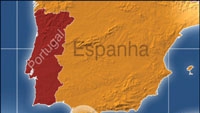Graphics and effects

Portuguese television station TVI used World Maps from Curious Software to create the map shown here. The software allows designers to create any number of templates, and journalists can apply them instantly to any geographical information they need.
Increasingly, fast computers offer graphics and effects software writers countless opportunities for improving the performance, functionality and interactivity of their tools. Is this going to change production methods or the nature of content?
In the film industry, the economics may change, but it is hard to see any significant deviation from the existing technological trend. The constant aim is to achieve greater realism, ever more complex effects, and seamless integration of the real and synthetic worlds. New technology, designed to make the task easier, only encourages directors to push it to new limits.
There is, however, a fundamental difference in the nature of work in a broadcast environment. As with effects shots, there is the relative luxury of time to generate some broadcast graphics such as program promos, opening sequences and standard graphics that accompany a series. But the day-to-day graphics for news output are different. While they must be produced on a much tighter deadline, they are more repetitive in nature, which provides an opportunity for improved operational efficiency.
There is also pressure for economic efficiency while continuing to satisfy the audience’s demand for higher quality. Most news organizations today must produce vastly more content than they have in the past. There are more channels to feed, programming is more graphic-rich, there are often Web sites to fill, and there is less money. This has already led a number of organizations to move towards centralized production of graphics, with subsequent distribution to remote sites and to multiple media.
Software technology has a role to play in bringing about a further, significant change in the way in which content is produced — achieving greater efficiency while also improving the quality of content created. Graphics creation is a 2-stage process. There is the highly skilled initial task of designing a graphic, and designing the look and layout. Then there is the repetitive task of creating the final content. Often the look of the majority of graphics does not change from day-to-day. Only the words or a picture element or a graph shape may change. This means that we can separate the design process from the final production, using systems that ‘encapsulate’ a design, and then allow anyone to produce the final content by filling in the changing details, while maintaining guaranteed fidelity to the design.
Distributed graphics creation
The professional video industry's #1 source for news, trends and product and tech information. Sign up below.
This concept can be carried forward to a much more radical change in the way that graphics are created for broadcast news. The structure of a broadcast graphics department has always been driven by the nature of the necessary equipment. Interactive graphics is very demanding of computer power. As a consequence, extremely expensive equipment has been required, concentrated in the graphics department and operated by highly-skilled, expensive people. Now, however, the power of PCs means that broadcast-quality animated graphics can be produced on every desktop. Graphics creation is no longer the sole domain of the graphics department.
Design should always be in the hands of skilled artists, but the task of filling in the final details can be distributed to those areas where the content is immediately required. This also frees up the artists to work on the flagship graphics projects that give a station its identity.
Distributed content creation already is becoming established in newsroom automation systems. A combination of distributed computing power, fast networks and design/template-based software that allows non-designers to choose the content used in a complex animated graphic makes the step to distributed graphics creation entirely feasible.
While the results may not be so obvious to the audience, the changes we now see in networked environments, and the universal availability of awesome computing power, will have every bit as dramatic an effect on the nature of broadcast graphics production as the arrival of digital technology itself.
Gareth Griffith is a co-founder of Curious Software.
